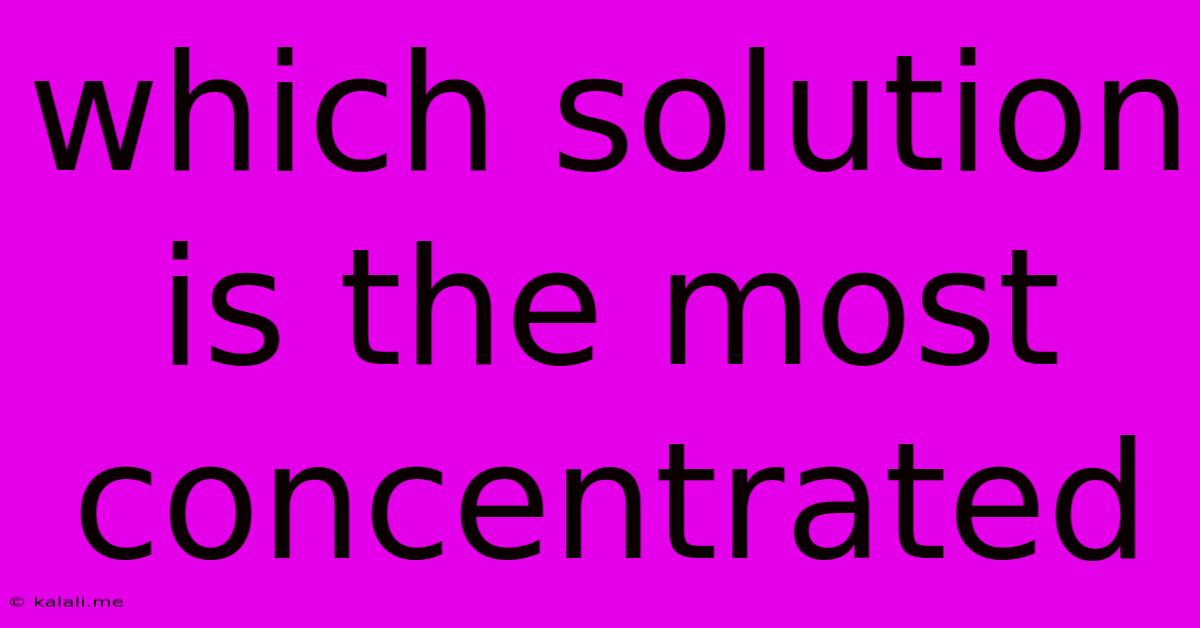Which Solution Is The Most Concentrated
Kalali
May 09, 2025 · 3 min read

Table of Contents
Which Solution is the Most Concentrated? Understanding Concentration and Molarity
Determining which solution is the most concentrated requires understanding the concept of concentration. While there are various ways to express concentration (percentage by mass, percentage by volume, molality, etc.), the most common and often the most useful in chemistry and related fields is molarity. This article will delve into how molarity helps us compare the concentration of different solutions and offer practical examples.
What is Molarity?
Molarity (M) is defined as the number of moles of solute per liter of solution. A solute is the substance being dissolved, and the solvent is the substance doing the dissolving (often water). The formula for molarity is:
Molarity (M) = moles of solute / liters of solution
A solution with a higher molarity contains more moles of solute per liter of solution and is therefore more concentrated.
Comparing Solutions Using Molarity
Let's consider a few examples to illustrate how we compare solution concentrations:
-
Example 1: Solution A contains 2 moles of sodium chloride (NaCl) in 1 liter of water, while Solution B contains 1 mole of NaCl in 1 liter of water. Solution A (2M) is more concentrated than Solution B (1M).
-
Example 2: Solution C has 0.5 moles of glucose in 0.25 liters of water, while Solution D has 1 mole of glucose in 1 liter of water. To compare, we need to calculate the molarity of each:
- Solution C: M = 0.5 moles / 0.25 L = 2M
- Solution D: M = 1 mole / 1 L = 1M
Even though Solution C has fewer moles of glucose overall, its molarity is higher, indicating it's more concentrated.
-
Example 3: Real-world application. Imagine you have two bottles of cleaning solution. One is labeled "10% bleach" and the other is labeled "5M sodium hypochlorite". To compare their concentrations directly, you'd need to convert the percentage solution to molarity (requiring knowledge of the solution's density) or the molar solution to a percentage. Since molarity provides a more precise measure of concentration, it is generally preferred in scientific contexts.
Beyond Molarity: Other Concentration Units
While molarity is frequently used, it's important to note other ways to express concentration:
-
Mass Percentage (% w/w): The mass of solute divided by the total mass of the solution, multiplied by 100.
-
Volume Percentage (% v/v): The volume of solute divided by the total volume of the solution, multiplied by 100.
-
Parts per million (ppm) and parts per billion (ppb): Used for very dilute solutions.
To compare solutions using these different units, you must convert them to a common unit, such as molarity, for a fair comparison of concentration.
Conclusion:
Determining which solution is most concentrated hinges on a clear understanding of concentration units. While percentage solutions are common in everyday life, molarity (M) offers a more precise and universally understood method for comparing the concentration of solutions, particularly in scientific and chemical applications. Remember to always consider the units and convert if necessary before making a direct comparison.
Latest Posts
Related Post
Thank you for visiting our website which covers about Which Solution Is The Most Concentrated . We hope the information provided has been useful to you. Feel free to contact us if you have any questions or need further assistance. See you next time and don't miss to bookmark.